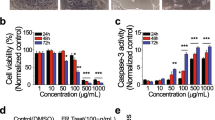Abstract
Background
Multidrug resistance in malignant tumours hinders the treatment of tumours. Studies showed that astragalus polysaccharides (APS), one major active ingredient of astragalus, enhanced the sensitivity of non-small cell lung cancer and liver cancer cells to chemotherapeutic drug. However, the effect of APS on ovarian cancer is still unclear. In this study, we will examine the sensitizing effect of APS on SKOV3 cells to cisplatin and explore the possible mechanism.
Methods
MTT assay was employed to examine the viability of SKOV3 after treatment with APS and cisplatin. The cell apoptosis rate was determined by flow cytometry. The expression of Bax, Bcl-2, Caspase-3, and c-Jun N-terminal kinases 1/2 (JNK1/2) was measured using Western blotting and RT-PCR.
Results
APS synergistically promoted the inhibitory effect of cisplatin on SKOV3 cell viability. Flow cytometry showed that APS promoted cisplatin-induced apoptosis of SKOV3 cell lines. Further studies showed that APS down-regulated the expression of Bcl2, increased the expression of Bax and caspase 3 and activated JNK1/2 signalling pathway. The JNK inhibitors significantly rescued the proliferation inhibition induced by the drugs.
Conclusions
Astragalus polysaccharides increased the sensitivity of SKOV3 cells to cisplatin potentially by activating the JNK pathway. The apoptosis-related genes may contribute to the process. Thus, APS may be useful for the treatment of ovarian cancer as an enhancer of chemosensitivity.





Similar content being viewed by others
References
Morgan RJ Jr, Alvarez RD, Armstrong DK et al (2013) Ovarian cancer, version 2.2013. J Natl Compr Canc Netw 11(10):1199–1209
Jemal A, Siegel R, Xu J, Ward E (2010) Cancer statistics. CA Cancer J Clin 60(5):277–300
Salomon-Perzyński A, Salomon-Perzyńska M, Michalski B, Skrzypulec-Plinta V (2017) High-grade serous ovarian cancer: the clone wars. Arch Gynecol Obstet 295:569–576
Eng KH, Hanlon BM, Bradley WH, Szender JB (2015) Prognostic factors modifying the treatment-free interval in recurrent ovarian cancer. Gynecol Oncol 139(2):228–235
Deng J, Guo Y, Jiang Z, Yang M, Li H, Wang J (2015) Enhancement of ovarian cancer chemotherapy by delivery of multidrug-resistance gene small interfering RNA using tumor targeting Salmonella. J Obstet Gynaecol Res 41(4):615–622
Wang NN, Zhao LJ, Wu LN et al (2013) Mechanistic analysis of taxol-induced multidrug resistance in an ovarian cancer cell line. Asian Pac J Cancer Prev 14(9):4983–4988
Wuerkenbieke D, Wang J, Li Y, Ma C (2015) miRNA-150 downregulation promotes pertuzumab resistance in ovarian cancer cells via AKT activation. Arch Gynecol Obstet 292:1109–1116
Tsubaki M, Satou T, Itoh T et al (2012) Overexpression of MDR1 and survivin, and decreased Bim expression mediate multidrug-resistance in multiple myeloma cells. Leuk Res 36(10):1315–1322
Zhao L, Gu C, Huang K et al (2016) The prognostic value and clinicopathological significance of CD44 expression in ovarian cancer: a meta-analysis. Arch Gynecol Obstet 294:1019–1029
Mahdizadeh S, Karimi G, Behravan J, Arabzadeh S, Lage H, Kalalinia F (2016) Crocin suppresses multidrug resistance in MRP overexpressing ovarian cancer cell line. Daru 24(1):17
Wang SQ, Liu ST, Zhao BX et al (2015) Afatinib reverses multidrug resistance in ovarian cancer via dually inhibiting ATP binding cassette subfamily B member 1. Oncotarget 6(28):26142–26160
Pu X, Ma X, Liu L et al (2016) Structural characterization and antioxidant activity in vitro of polysaccharides from angelica and astragalus. Carbohydr Polym 137:154–164
Jiao J, Gai GQ, Wang W, Luo M et al (2016) Enhanced astragaloside production and transcriptional responses of biosynthetic genes in astragalus membranaceus hairy root cultures by elicitation with methyljasmonate. Biochem Eng J 105:339–346
Tian QE, Li HD, Yan M, Cai HL, Tan QY, Zhang WY (2012) Astragalus polysaccharides can regulate cytokine and P-glycoprotein expression in H22 tumour-bearing mice. World J Gastroenterol 18(47):7079–7086
Guo L, Bai SP, Zhao L, Wang XH (2012) Astragalus polysaccharide injection integrated with vinorelbine and cisplatin for patients with advanced non-small cell lung cancer: effects on quality of life and survival. Med Oncol 29(3):1656–1662
Sartorius UA, Krammer PH (2002) Upregulation of Bcl-2 is involved in the mediation of chemotherapy resistance in human small cell lung cancer cell lines. Int J Cancer 97(5):584–592
Garrido C, Galluzzi L, Brunet M, Puig PE, Didelot C, Kroemer G (2006) Mechanisms of cytochrome c release from mitochondria. Cell Death Differ 3(9):1423–1433
Zhao H, Yenari MA, Cheng D, Sapolsky RM, Steinberg GK (2003) Bcl-2 overexpression protects against neuron loss within the ischemic margin following experimental stroke and inhibits cytochrome c translocation and Caspase-3 activity. J Neurochem 85(4):1026–1036
Chien CC, Wu MS, Shen SC, Ko CH, Chen CH, Yang LL, Chen YC (2014) Activation of JNK contributes to evodiamine-induced apoptosis and G2/M arrest in human colorectal carcinoma cells: a structure-activity study of evodiamine. PLoS One 9(6):e99729
Heasley LE, Han SY (2006) JNK regulation of oncogenesis. Mol Cells 21(2):167–173
Zhou J, Liu M, Aneja R, Chandra R, Lage H, Joshi HC (2006) Reversal of P-glycoprotein-mediated multidrug resistance in cancer cells by the c-Jun NH2-terminal kinase. Cancer Res 66(1):445–452
Wei Y, Pattingre S, Sinha S, Bassik M, Levine B (2008) JNK1-mediated phosphorylation of Bcl-2 regulates starvation-induced autophagy. Mol Cell 30(6):678–688
Acknowledgements
We thank Wei Liu, Cheng Liu, Jie Min, Wenjun Guo and Ye Qin for all their help with the experimental design and the improvements to this paper.
Author information
Authors and Affiliations
Contributions
Study design: CL. Literature research: CL. Clinical studies: JM, MH. Data acquisition and analysis: WG. Statistical analysis: CL. Manuscript preparation: CL, LH. Manuscript editing: CL, LH. Manuscript review: CL, LH.
Corresponding author
Ethics declarations
Conflict of interest
The authors declare that they have no conflict of interest.
Research involving human participants and/or animals
Not applicable.
Informed consent
Not applicable.
Rights and permissions
About this article
Cite this article
Li, C., Hong, L., Liu, C. et al. Astragalus polysaccharides increase the sensitivity of SKOV3 cells to cisplatin. Arch Gynecol Obstet 297, 381–386 (2018). https://doi.org/10.1007/s00404-017-4580-9
Received:
Accepted:
Published:
Issue Date:
DOI: https://doi.org/10.1007/s00404-017-4580-9




